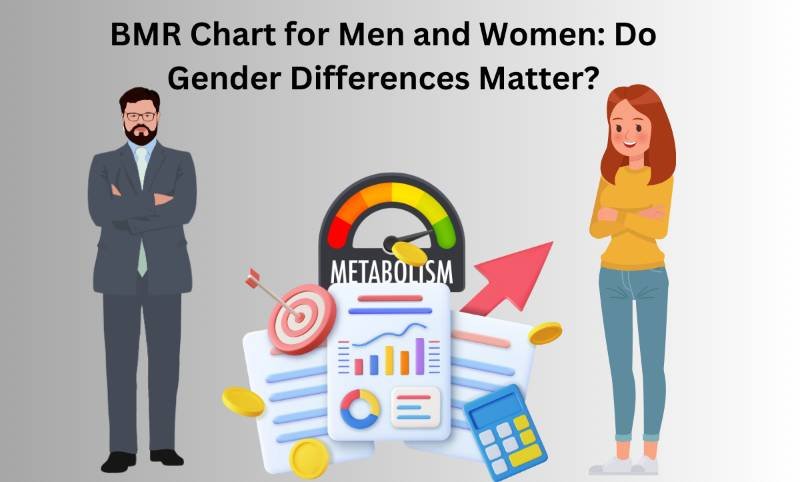BMR Chart for Men and Women: Does Gender Play a Role?

BMR Chart for Men and Women: Does Gender Play a Role?
Are you trying to lose or gain weight, or get fit? Good understanding of Basal Metabolic Rate will benefit you. Now, why is it the case that BMR goes along in two human beings of different genders? Is this a question of gender difference when it comes to BMR calculation and interpretation? Let’s have it out.
What Is BMR?
Basal Metabolic Rate simply put is how many calories your body requires to maintain basic functions such as breathing, heartbeat, and digestion. In short, BMR shows you exactly how many calories you would burn if you ever slept in bed all day long. Knowing this can sometimes help set realistic goals be it losing, maintaining, or gaining.
To calculate BMR, one may use a BMR calculator or simply input your data into a formula. Probably, the most well-known equation is Harris-Benedict Equation, which takes into account your weight, height, age, and gender.
How to Calculate BMR
A BMR calculator on the internet will require very few inputs, and still, it asks for your age, gender, weight, and height so that it can give you an approximate value for the calories that your body needs. Taking it to the next level, a TDEE calculator takes your activity level into consideration and helps you figure out how many calories you are actually burning on average on a day.
BMR Formula:
For men:
BMR= 88.362 + (13.397 x weight in kilograms) + (4.799 x height in centimeters)- (5.677 x age in years)
For women:
BMR= 447.593 + (9.247 x weight in kilograms) + (3.098 x height in centimeters) – (4.330 x age in years)
You’ll notice that a standard formula for men yields a higher BMR than women. So, why is this the case?
Do Gender Differences Make a Difference in BMR?
Yes. Gender is a significant determinant of BMR. Men have a higher BMR than women. The reason is :
Muscle Mass: Men possess a higher muscle mass than women. Their muscles also burn more calories than the fat in their bodies even when they are sitting idle. Automatically, this brings about a higher calorie burn for men just because of possessing a higher amount of muscle.
Body Composition: Women also tend to possess a higher percentage of body fat that burns fewer calories than the muscle. The difference in body composition, therefore, brings about a lesser BMR for women.
Hormonal Variation: As there are various hormones which are present in greater or lesser proportions in men and women, including testosterone that appears to be more predominant in men, and estrogen that is predominant in women, this impacts on the muscle mass and fat storage. As a result, the BMR is also altered.
The difference now becomes relevant to use while applying a BMR to shed some weight. Men and women might need to explain their calorie intake, exercise patterns, and other eating habits in altogether different manners when referring to their respective metabolic rates.
Applying BMR in the Context of Weight Loss
After knowing your BMR, you can use it when targeting losing weight. Loser of body weight would require a decrease in calorie intake so that the body consumes more calories than it takes in. As for how much to cut back, that is where TDEE comes in.
TDEE is an abbreviation for Total Daily Energy Expenditure. It encompasses both BMR and calories burned while doing life activity. A TDEE calculator can be used to estimate how many calories one needs per day in order to continue losing or maintaining their weight. Of course, in order to lose weight, one must be consuming fewer calories than their TDEE, thus causing a calorie deficit.
For example, if your TDEE is 2,500 calories and you wish to lose weight, you could probably aim for a daily intake of 2,000 calories per day, depending on what you want to achieve in the fitness process and how active you are.
Do BMR Calculators Really Deliver Accurate Results?
Useful tools, to be sure, but keep in mind that online BMR calculators, as well as TDEE ones, can only provide estimates, and individual fluctuations in their results can come about through distribution of muscle mass, percentages of body fat, and individual health. Exercise, and especially resistance training, increases muscle mass – so the Basal Metabolic Rate increases with time.
Categories
Latest Posts
- The Evolution of GST Calculators: From Manual to Online Tools
- 10 Mistakes to Avoid While Using an EMI Calculator
- Top Benefits of Using an Online EMI Calculator for Financial Planning
- 5 Common Mistakes to Avoid When Using an EMI Calculator
- How to Use an EMI Calculator to Plan Prepayments and Reduce Your Loan Tenure
- The Future of EMI Calculators: AI-Powered Features to Expect in Fintech Tools

